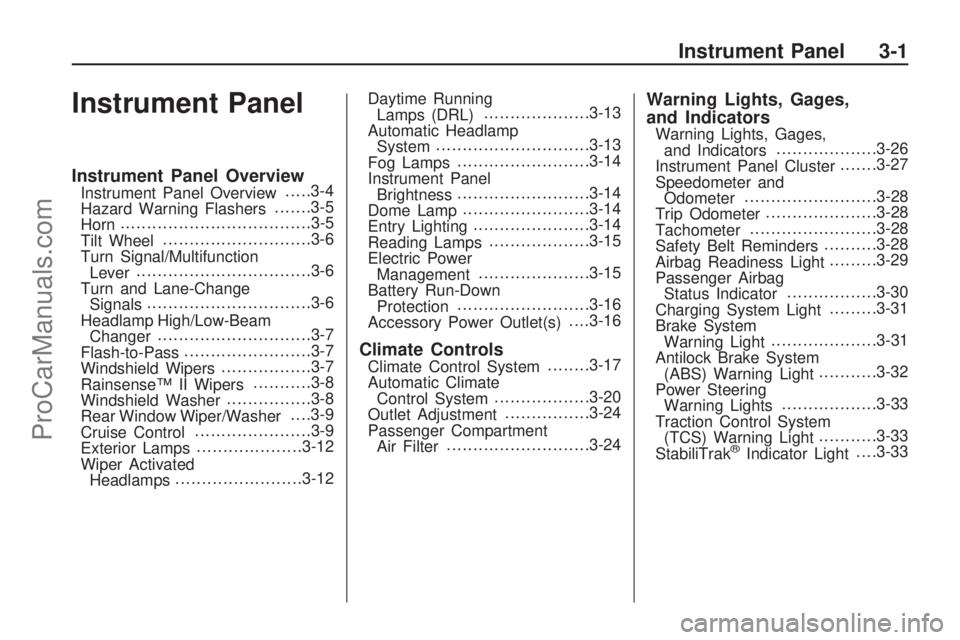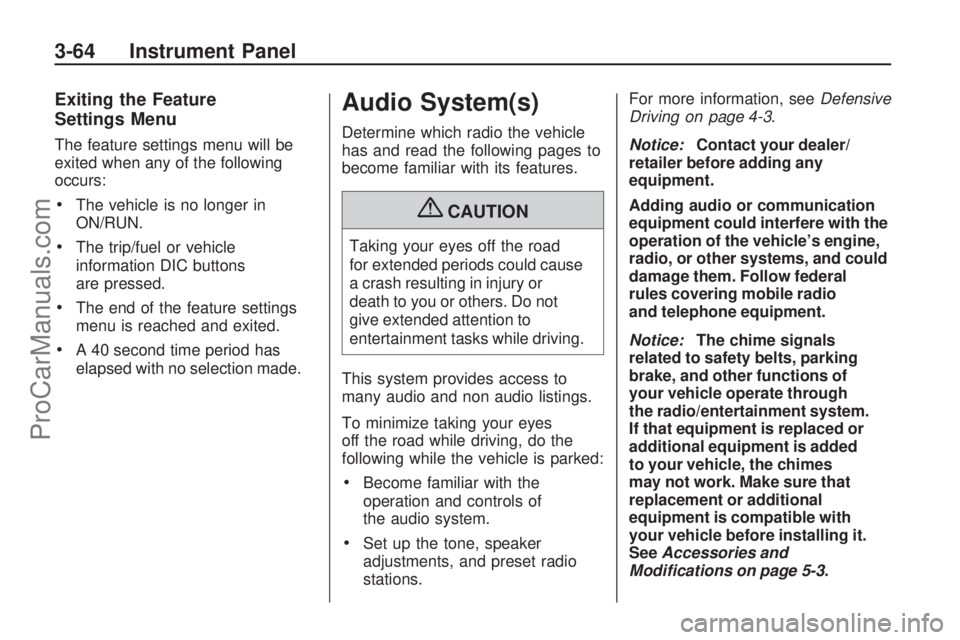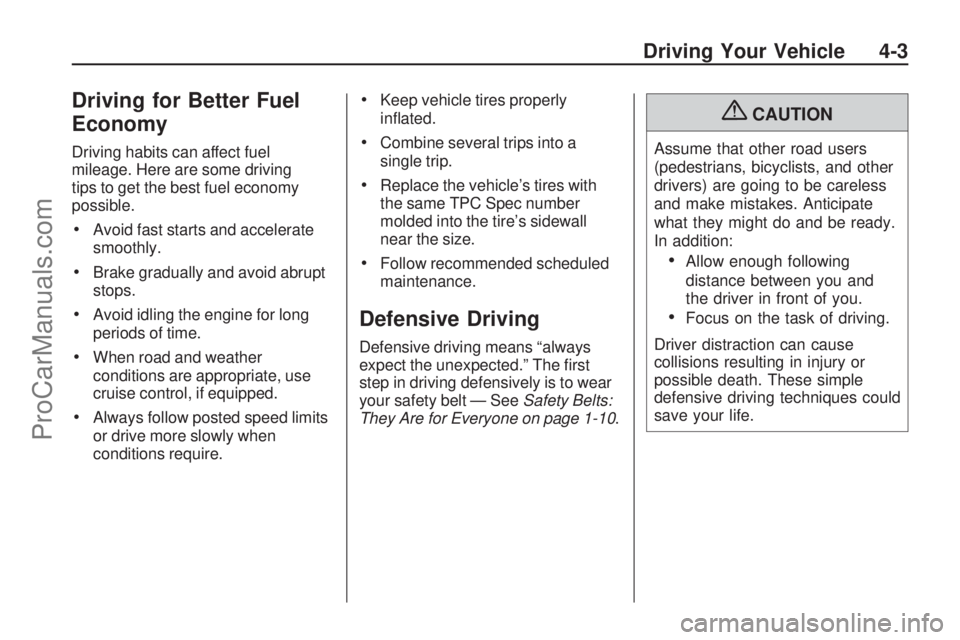belt SATURN VUE 2009 Service Manual
[x] Cancel search | Manufacturer: SATURN, Model Year: 2009, Model line: VUE, Model: SATURN VUE 2009Pages: 386, PDF Size: 2.3 MB
Page 63 of 386

Replacing Restraint
System Parts After a
Crash
{CAUTION
A crash can damage the
restraint systems in your vehicle.
A damaged restraint system may
not properly protect the person
using it, resulting in serious injury
or even death in a crash. To help
make sure your restraint systems
are working properly after a crash,
have them inspected and any
necessary replacements made as
soon as possible.If the vehicle has been in a crash,
do you need new safety belts
or LATCH system (if equipped)
parts?
After a very minor crash, nothing
may be necessary. But the
safety belt assemblies that were
used during any crash may
have been stressed or damaged.
See your dealer/retailer to have the
safety belt assemblies inspected
or replaced.
If the vehicle has the LATCH
system and it was being used
during a crash, you may need
new LATCH system parts.New parts and repairs may be
necessary even if the safety belt
or LATCH system (if equipped), was
not being used at the time of the
crash.
If an airbag in�ates, you will need
to replace airbag system parts.
See the part on the airbag system
earlier in this section.
Have the safety belt pretensioners
checked if the vehicle has been in a
crash, if the airbag readiness light
stays on after the vehicle is started,
or while you are driving. See
Airbag Readiness Light on
page 3-29.
Seats and Restraint System 1-59
ProCarManuals.com
Page 71 of 386

The vehicle must be started with
the key once two remote starts, or a
single remote start with one time
extension has been done.
The vehicle can be started using
the remote start feature again after
the key is removed from the ignition.
The vehicle cannot be started using
the remote start feature if the key is
in the ignition, the hood is open, or if
there is an emission control system
malfunction.
The engine turns off during a remote
start if the coolant temperature gets
too high or if the oil pressure gets low.
Remote Start Ready
If the vehicle does not have the
remote vehicle start feature, it may
have the remote start ready feature.
This feature allows your dealer/
retailer to add the manufacturer’s
remote vehicle start feature.
To add the manufacturer’s remote
vehicle start feature to the vehicle,
see your dealer/retailer.
Doors and Locks
Door Locks
{CAUTION
Unlocked doors can be
dangerous.
Passengers, especially
children, can easily open
the doors and fall out of a
moving vehicle. When a
door is locked, the handle
will not open it. The chance
of being thrown out of the
vehicle in a crash is increased
if the doors are not locked.
So, all passengers should
wear safety belts properly
and the doors should be
locked whenever the vehicle
is driven.
(Continued)
CAUTION (Continued)
Young children who get into
unlocked vehicles may be
unable to get out. A child can
be overcome by extreme heat
and can suffer permanent
injuries or even death from
heat stroke. Always lock the
vehicle whenever leaving it.
Outsiders can easily enter
through an unlocked door
when you slow down or stop
your vehicle. Locking your
doors can help prevent this
from happening.
To lock or unlock a door, use the
key from the outside or the door lock
from the inside.
Features and Controls 2-7
ProCarManuals.com
Page 111 of 386

Instrument Panel
Instrument Panel OverviewInstrument Panel Overview.....3-4
Hazard Warning Flashers.......3-5
Horn....................................3-5
Tilt Wheel............................3-6
Turn Signal/Multifunction
Lever.................................3-6
Turn and Lane-Change
Signals...............................3-6
Headlamp High/Low-Beam
Changer.............................3-7
Flash-to-Pass........................3-7
Windshield Wipers.................3-7
Rainsense™ II Wipers...........3-8
Windshield Washer................3-8
Rear Window Wiper/Washer. . . .3-9
Cruise Control......................3-9
Exterior Lamps....................3-12
Wiper Activated
Headlamps........................3-12Daytime Running
Lamps (DRL)....................3-13
Automatic Headlamp
System.............................3-13
Fog Lamps.........................3-14
Instrument Panel
Brightness.........................3-14
Dome Lamp........................3-14
Entry Lighting......................3-14
Reading Lamps...................3-15
Electric Power
Management.....................3-15
Battery Run-Down
Protection.........................3-16
Accessory Power Outlet(s). . . .3-16
Climate ControlsClimate Control System........3-17
Automatic Climate
Control System..................3-20
Outlet Adjustment................3-24
Passenger Compartment
Air Filter...........................3-24
Warning Lights, Gages,
and Indicators
Warning Lights, Gages,
and Indicators...................3-26
Instrument Panel Cluster.......3-27
Speedometer and
Odometer.........................3-28
Trip Odometer.....................3-28
Tachometer........................3-28
Safety Belt Reminders..........3-28
Airbag Readiness Light.........3-29
Passenger Airbag
Status Indicator.................3-30
Charging System Light.........3-31
Brake System
Warning Light....................3-31
Antilock Brake System
(ABS) Warning Light...........3-32
Power Steering
Warning Lights..................3-33
Traction Control System
(TCS) Warning Light...........3-33
StabiliTrak
®Indicator Light. . . .3-33
Instrument Panel 3-1
ProCarManuals.com
Page 115 of 386

The main components of the
instrument panel are the following:
A.Outlet Adjustment on
page 3-24.
B.Instrument Panel Brightness on
page 3-14.
C.Turn Signal/Multifunction Lever
on page 3-6.
D.Instrument Panel Cluster on
page 3-27.
E.Windshield Wipers on page 3-7.
F.Audio System(s) on page 3-64.
G. Auxiliary Input Jack.
SeeRadio(s) on page 3-67.
H.Fog Lamps on page 3-14.
Exterior Lamps on page 3-12.
I.Driver Information Center (DIC)
on page 3-42.
J.Instrument Panel Storage on
page 2-42.
K.Hood Release on page 5-11.
L.Cruise Control on page 3-9.
M.Tilt Wheel on page 3-6.N.Horn on page 3-5.
O.Audio Steering Wheel Controls
on page 3-92.
P.Rear Window Wiper/Washer on
page 3-9.
Q.Traction Control System (TCS)
on page 4-8.
R. Shift Lever. SeeAutomatic
Transmission Operation
(Uplevel) on page 2-19or
Automatic Transmission
Operation (Base) on page 2-22.
S.Climate Control System on
page 3-17orAutomatic Climate
Control System on page 3-20
(If Equipped).
T.Hazard Warning Flashers on
page 3-5.
U.Passenger Airbag Status
Indicator on page 3-30.
V.Safety Belt Reminders on
page 3-28.
W.Glove Box on page 2-41.Hazard Warning Flashers
|
(Hazard Warning Flasher):
Press this button located on the
instrument panel, to make the front
and rear turn signal lamps �ash on
and off. This warns others that you
are having trouble.
Press
|again to turn the
�ashers off.
Horn
Press near or on the horn symbols
on the steering wheel pad to sound
the horn.
Instrument Panel 3-5
ProCarManuals.com
Page 138 of 386

Speedometer and
Odometer
The speedometer shows the
vehicle’s speed in both miles per
hour (mph) and kilometers per
hour (km/h).
The odometer shows how far
the vehicle has been driven, in
either miles or kilometers.
If the vehicle needs a new odometer
installed, the new one is set to the
mileage total of the old odometer.
If it cannot, it will be set at zero and
a label must be put on the driver’s
door to show the old mileage reading
when the new odometer was
installed. If the mileage is unknown,
the label should then indicate that the
previous mileage is unknown.
Trip Odometer
The trip odometer can record
the number of miles, used in the
United States, or kilometers, used in
Canada, traveled for up to two trips.
Cycle between the odometer and
trip odometers A and B by pressing
the reset button located in the
lower right area of the speedometer.
Press the reset button to tell how
many miles or kilometers have been
recorded on either Trip A or Trip B
since the trip odometer was last
set back to zero.
To reset each trip odometer to zero,
press and hold the reset button.
The reset button resets only the trip
odometer that is being displayed.
Each trip odometer must be reset
individually.
Tachometer
The tachometer displays the
engine speed in revolutions per
minute (rpm).
Safety Belt Reminders
Driver Safety Belt Reminder
Light
When the engine is started,
a chime sounds for several seconds
to remind the driver to fasten their
safety belt, unless it is already
buckled.
The safety belt light comes on
and stays on for several seconds,
then �ashes for several more.
This chime and light are repeated
if the driver safety belt remains
unbuckled and the vehicle is
in motion. If the driver safety belt
is already buckled, neither the
chime nor the light comes on.
3-28 Instrument Panel
ProCarManuals.com
Page 139 of 386

Passenger Safety Belt
Reminder Light
Several seconds after the engine
is started, a chime sounds for
several seconds to remind the front
passenger to buckle their safety belt.
This only occurs if the passenger
airbag is enabled. SeePassenger
Sensing System on page 1-51for
more information. The passenger
safety belt light, located on the
instrument panel, comes on and
stays on for several seconds and
then �ashes for several more.
This chime and light are repeated if
the passenger remains unbuckled
and the vehicle is in motion.
If the passenger safety belt is
buckled before the engine is started,
neither the chime nor the light
comes on.The front passenger safety belt
warning light and chime may turn on
if an object is put on the seat such as
a briefcase, handbag, grocery bag,
laptop or other electronic device.
To turn off the warning light and or
chime, remove the object from the
seat or buckle the safety belt.
Airbag Readiness Light
There is an airbag readiness light
on the instrument panel cluster,
which shows the airbag symbol.
The system checks the airbag’s
electrical system for malfunctions.
The light indicates if there is an
electrical problem. The system
check includes the airbag sensor,
the pretensioners, the airbag
modules, the wiring and the crash
sensing and diagnostic module.
For more information on the airbag
system, seeAirbag System on
page 1-42.
{CAUTION
If the airbag readiness light stays
on after the vehicle is started or
comes on while driving, it means
the airbag system might not be
working properly. The airbags in
the vehicle might not in�ate in a
crash, or they could even in�ate
without a crash. To help avoid
injury, have the vehicle serviced
right away.
The airbag readiness light comes
on when the vehicle is started, and
�ashes for a few seconds. The light
goes out when the system is ready.
Instrument Panel 3-29
ProCarManuals.com
Page 174 of 386

Exiting the Feature
Settings Menu
The feature settings menu will be
exited when any of the following
occurs:
The vehicle is no longer in
ON/RUN.
The trip/fuel or vehicle
information DIC buttons
are pressed.
The end of the feature settings
menu is reached and exited.
A 40 second time period has
elapsed with no selection made.
Audio System(s)
Determine which radio the vehicle
has and read the following pages to
become familiar with its features.
{CAUTION
Taking your eyes off the road
for extended periods could cause
a crash resulting in injury or
death to you or others. Do not
give extended attention to
entertainment tasks while driving.
This system provides access to
many audio and non audio listings.
To minimize taking your eyes
off the road while driving, do the
following while the vehicle is parked:
Become familiar with the
operation and controls of
the audio system.
Set up the tone, speaker
adjustments, and preset radio
stations.For more information, seeDefensive
Driving on page 4-3.
Notice:Contact your dealer/
retailer before adding any
equipment.
Adding audio or communication
equipment could interfere with the
operation of the vehicle’s engine,
radio, or other systems, and could
damage them. Follow federal
rules covering mobile radio
and telephone equipment.
Notice:The chime signals
related to safety belts, parking
brake, and other functions of
your vehicle operate through
the radio/entertainment system.
If that equipment is replaced or
additional equipment is added
to your vehicle, the chimes
may not work. Make sure that
replacement or additional
equipment is compatible with
your vehicle before installing it.
SeeAccessories and
Modifications on page 5-3.
3-64 Instrument Panel
ProCarManuals.com
Page 206 of 386

Driver Behavior
The single most important thing is
this: everyone in the vehicle,
including the driver, should buckle
up. SeeSafety Belts: They Are for
Everyone on page 1-10. In fact, most
serious injuries and fatalities to
unbelted occupants can be reduced
or prevented by the use of safety
belts. In a rollover crash, an unbelted
person is signi�cantly more likely to
die than a person wearing a seat
belt. In addition, avoiding excessive
speed, sudden or abrupt turns, and
drunken or aggressive driving can
help make trips safer and avoid the
possibility of a crash, especially a
rollover crash. This section provides
many useful tips to help you drive
more safely.
Driving Environment
You can also help avoid a rollover
or other type of crash by being
prepared for driving in inclement
weather, at night, or during other
times where visibility or traction
may be limited, such as on curves,
slippery roads, or hilly terrain.
Unfamiliar surroundings can also
have hidden hazards.
To help you learn more about driving
in different conditions, this section
contains information about city,
freeway, and off-road driving, as well
as other hints for driving in various
weather conditions.
Vehicle Design
According to the U.S. Department
of Transportation, utility vehicles
have a signi�cantly higher rollover
rate than other types of vehicles.Utility vehicles do have higher
ground clearance and a narrower
track or shorter wheelbase than
passenger cars, to make them more
capable for off-road driving. Speci�c
design characteristics like these give
the driver a better view of the road,
but also give utility vehicles a higher
center of gravity than other types of
vehicles. This means that you should
not expect a utility vehicle to handle
the same way a vehicle with a lower
center of gravity, like a car, would in
similar situations.
But driver behavior factors are
far more often the cause of a
utility vehicle rollover than
are environmental or vehicle
factors. Safe driver behavior and
understanding the environment in
which you will be driving can help
avoid a rollover crash in any type of
vehicle, including utility vehicles.
4-2 Driving Your Vehicle
ProCarManuals.com
Page 207 of 386

Driving for Better Fuel
Economy
Driving habits can affect fuel
mileage. Here are some driving
tips to get the best fuel economy
possible.
Avoid fast starts and accelerate
smoothly.
Brake gradually and avoid abrupt
stops.
Avoid idling the engine for long
periods of time.
When road and weather
conditions are appropriate, use
cruise control, if equipped.
Always follow posted speed limits
or drive more slowly when
conditions require.
Keep vehicle tires properly
in�ated.
Combine several trips into a
single trip.
Replace the vehicle’s tires with
the same TPC Spec number
molded into the tire’s sidewall
near the size.
Follow recommended scheduled
maintenance.
Defensive Driving
Defensive driving means “always
expect the unexpected.” The �rst
step in driving defensively is to wear
your safety belt — SeeSafety Belts:
They Are for Everyone on page 1-10.
{CAUTION
Assume that other road users
(pedestrians, bicyclists, and other
drivers) are going to be careless
and make mistakes. Anticipate
what they might do and be ready.
In addition:
Allow enough following
distance between you and
the driver in front of you.
Focus on the task of driving.
Driver distraction can cause
collisions resulting in injury or
possible death. These simple
defensive driving techniques could
save your life.
Driving Your Vehicle 4-3
ProCarManuals.com
Page 215 of 386

An emergency like this requires
close attention and a quick decision.
If holding the steering wheel at the
recommended 9 and 3 o’clock
positions, it can be turned a full
180 degrees very quickly without
removing either hand. But you have
to act fast, steer quickly, and just as
quickly straighten the wheel once
you have avoided the object.
The fact that such emergency
situations are always possible is a
good reason to practice defensive
driving at all times and wear
safety belts properly.
Off-Road Recovery
The vehicle’s right wheels can drop
off the edge of a road onto the
shoulder while driving.
If the level of the shoulder is
only slightly below the pavement,
recovery should be fairly easy. Ease
off the accelerator and then, if there
is nothing in the way, steer so that
the vehicle straddles the edge of
the pavement. Turn the steering
wheel 3 to 5 inches, 8 to 13 cm,
(about one-eighth turn) until the right
front tire contacts the pavement
edge. Then turn the steering wheel to
go straight down the roadway.
Passing
Passing another vehicle on a
two-lane road can be dangerous.
To reduce the risk of danger
while passing:
Look down the road, to the sides,
and to crossroads for situations
that might affect a successful
pass. If in doubt, wait.
Watch for traffic signs,
pavement markings, and lines
that could indicate a turn or an
intersection. Never cross a solid
or double-solid line on your side of
the lane.
Do not get too close to the vehicle
you want to pass. Doing so can
reduce your visibility.
Wait your turn to pass a slow
vehicle.
When you are being passed, ease
to the right.
Driving Your Vehicle 4-11
ProCarManuals.com